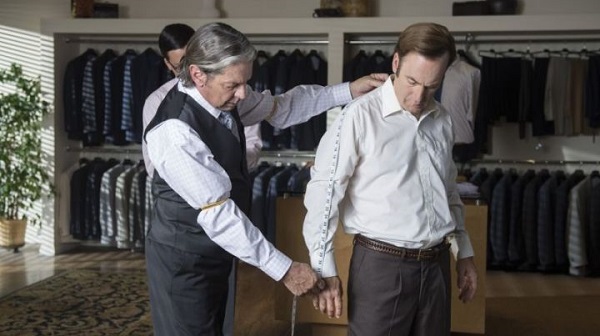
Written by Gennifer Hutchison
Directed by Colin Bucksey
Airs Mondays at 10PM EST on AMC
It should be no surprise at this point that Better Call Saul is building a pretty impressive following from its AMC audience. The shows quality has been shining like a beacon from the opening moments of its very first episode. What is surprising, though, is how it continues to reveal so many layers to a character who, while always entertaining in his original iteration, never really seemed all that complex.
The first shocker comes in the follow-up to last week’s cliffhanger, in which Saul found the Kettlemans camped out in the desert a few miles from their home. With the cat out of the bag, a cat that happens to be made out of a whole lot of stolen money, Saul is faced with yet another moral crisis, as the Kettlemans attempt to bribe him to simply “forget what he saw.” Amazingly, Saul turns down the bribe (twice!) before trying to sway it into a retainer, and obtain them as clients like he had initially hoped. It’s a scene like many others that have occurred up until this point, in that it forces us to once again recalibrate the way we see this character, and adjust for inflation given what we know about his future.

Speaking of inflation, while that opening leaves it up for question whether Saul will take the money, the following one where he brooks no negotiation or argument with our long standing parking attendant, Mike Ehrmantraut, puts that baby to bed rather quickly. The dubious look Mike gives him is more than enough to elicit an obvious conclusion, one that is confirmed very quickly when we see Saul with a stack of money trying to explain away his newfound capital by flippantly making expenses up on the fly. It’s another moment that reminds the audience that Odenkirk began his career as a standup comedian, and just how effortlessly he can inject humor into a scene.
Some of the Saul Goodman we have come to know begins to take shape in the deliberately tacky way that he rips off the Hamlin brand in an effort to establish himself with his new found wealth, while simultaneously twisting the knife into his professional nemesis. Yet another parallel emerges with Breaking Bad‘s Walter White, in that Saul’s first order of business when he comes into a pile of money is to reassert himself over his competitor and vindictively attack Hamlin purely for the personal satisfaction it brings him.
The centerpiece of the hour and obvious episode highlight comes when a cease and desist letter is drawn by Hamlin, and a wildly manipulative Saul pays to have a personal interest story done about him just as “an unfortunate accident” occurs behind him, with Saul “reluctantly” springing into action and rescuing the “distressed” billboard worker. This is easily the funniest scene Better Call Saul has produced yet (which is already saying something) and it works so well because of how gradually it lets viewers in on the joke, first with Saul obsessively framing the shot, then with the obvious reveal that he staged the whole thing. The clear overacting and hilariously “suspenseful” can-he-reach-him ending is just a thick layer of icing that further cements this as one of the highlights of the series thus far. Still another comedic blip comes moments later when Saul’s answering machine magic trick finally works, and the soaring number of 7 replaces the 0 with which he has generally been greeted.

The next thing that becomes clear following Saul’s sudden good fortune, is that the only opinion with which he is really concerned is that of his older brother, Chuck. The lengths that he goes to obscure the truth of his changing luck from his brother include fabricating a story, tossing Chuck’s newspaper in a dumpster, and dancing carefully around the truth during conversation.
When a suspicious Chuck decides to make a space-blanket-clad journey out into the dangers of the real world, Better Call Saul once again see-saws between making light of Chuck’s plight and showing the danger and sadness of his mental condition, making for something of a challenging scene that works in spades. The camera work is especially admirable here, jumping through multiple perspectives and styles to show Chuck’s version of events as opposed to the way they appear to the outside world. When he covers himself up a moment later, after achieving safety back at home and encountering the truth, the audience is left to wonder just which harmful element he is shielding himself from. As Better Call Saul‘s lightest hour by a long margin, “Hero” has opened up another bag of tricks narratively for the series, and will likely stand as a season 1 highlight.

